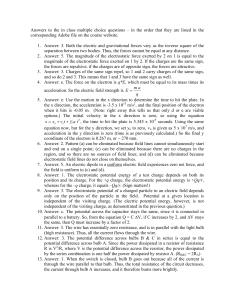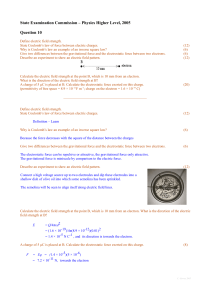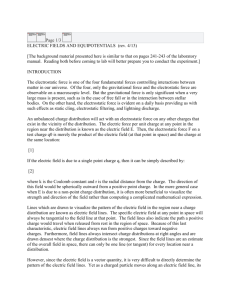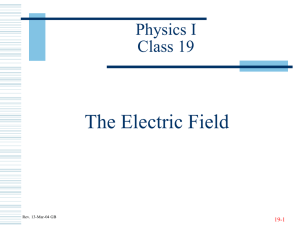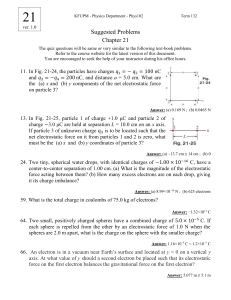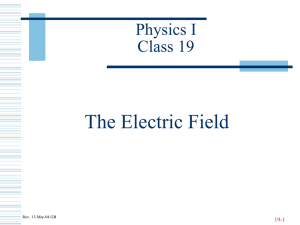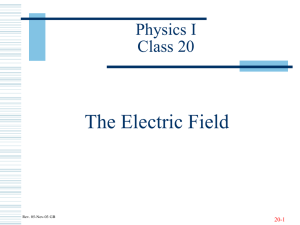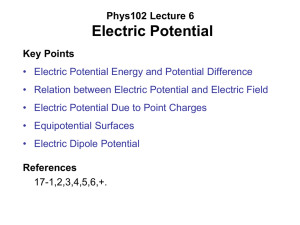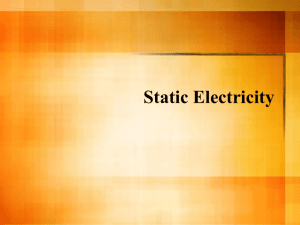Electrostatics: Charge, Coulomb's Law, Electric Fields
advertisement
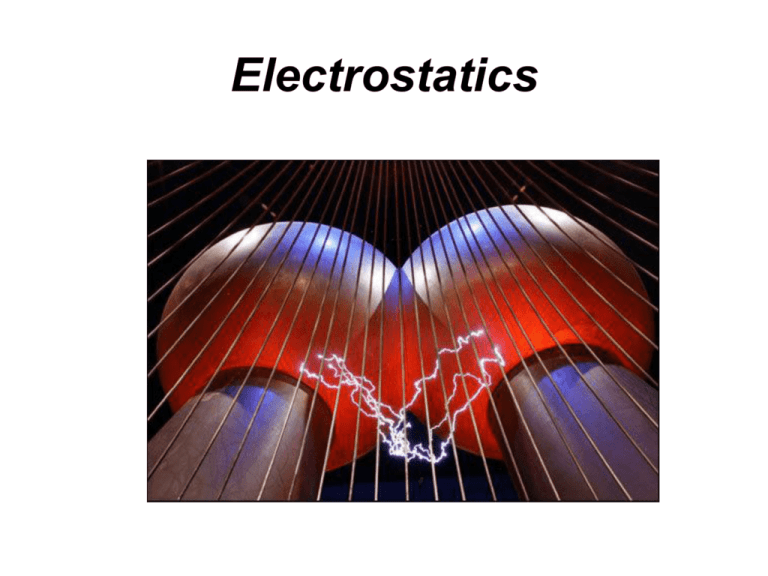
Electrostatics Which spheres experience the greatest attraction? Properties of “Charge” • Reflects relative number of electrons in a substance • Conserved • Units of Coulombs (C) • An electron has a charge of 1.6 x 10-19C of charge Significant Charge Amounts • When we rub balloons on rabbit hair in the lab, we’re generating 10’s of mC Coulomb's Law • Coulomb’s Law gives us a way to calculate the force between two charged objects • FE = kq1q2 /d2 • **Note: q1 and q2 represent charge magnitudes (we’ll talk about direction later) • k is a constant = 8.99 x 109 N m2/C2 Similarities to Gravity • Recall how we calculated the gravitational force between objects: • FG = Gm1m2/d2 • G is a constant = 6.67 x 10-11 N m2/kg2 • Look familiar? Different Constants • G = 6.67E-11, k = 8.99e9 • What does this tell us about the difference between gravitational forces and electrostatic forces? Examine the configuration below. Which charge would exert the greatest force on the -2 charge? • 1. +8 • 3. +6 2. +4 4. +20 Which list below ranks the charges in order of increasing force on the -2 charge? • • • • • 1. 2. 3. 4. 5. A, B, D, C A, C, B, D D, C, B, A C, A, B, D D, B, C, A Which arrow represents the direction of the net force on the -2 charge? • Calculate the electrostatic force on a +6mC charge by a -5mC charge, located 2m to its left • F = .067 N, to the left Balloon Demo • Calculate the electrostatic force between a proton in the nucleus of the atom (q = +1.60e-19C) and an electron (q = -1.60e19C) located in an outer energy level (d = 3e-11m) • Calculate the electron’s acceleration Levitation • I once heard a person ask, couldn’t you make a person float using charges? • Perhaps • Imagine a person (m = 70kg) gathered 10mC of charge by rubbing herself with rabbit fur • What charge would we need to lift her off the ground? What is this? “Scaling Force” • • • • Recall Newton’s second law: The ratio of Force/mass is acceleration What is the analog for charged particles? Force/charge = • We call this ratio the electric field Electric Fields • Like gravity, the electrostatic force is a non-contact force • To conceptually deal with this, we talk about electric fields • This is a region of space surrounding a charged particle that “carries” the electrostatic force • An electric field tells us the direction of the electrostatic force • It also gives us a sense of the force magnitude Drawing the Field • Place a positive “test” charge near a charge, or charge configuration • Determine the direction of the net force acting on that positive charge • Draw an arrow in that direction (arrow length represents force magnitude) • Move the charge to another place and repeat • Field lines start/end at infinity (somewhat hard to draw…) • Negative charges? • With both of these configurations, what happens to field strength as I get further and further from the charge? • Can you envision a scenario in which field strength remains constant? Field Strength • Imagine two, positive charges of charge q, separated by distance d. What is E for one of those two? • E = k|q|/d2 • Units of N/C • As they are vectors, fields add together as vectors do Draw the Field for this charge configuration: Find the field strength at point p (q = 5.0 mC) Is there a point at which E = 0? Other configurations • http://phet.colorado.edu/new/simulations/si ms.php?sim=Charges_and_Fields Levitation • Imagine a human being of mass 75kg • If she were to somehow acquire an excess charge of 20mC by vigorously rubbing rabbit fur on a dry day, what field strength would be necessary to levitate her above the ground? • Which way would the field point? Calculate the acceleration of an electron (m = 9E-31kg, q = 1.6E-19C), placed in a field of strength 3E-7 N/C

